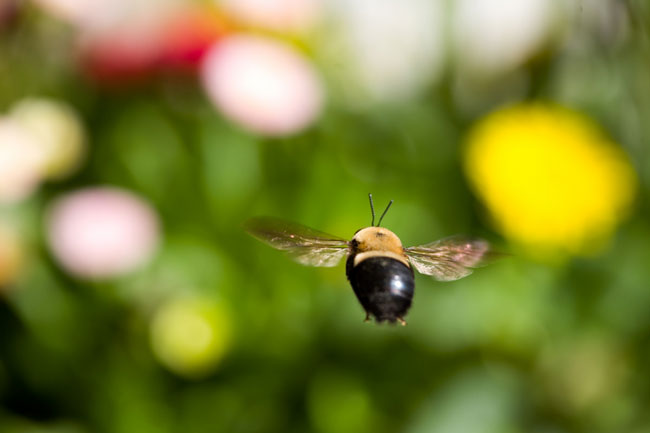4 Bumblebee Species on the Decline in North America

The populations of four species of North American bumblebee have declined, a new study has confirmed. The study also found that fungal infections are more likely to plague these bees than other, more stable bumblebee species.
Although perhaps not as dramatic as the sudden disappearance of honeybees, a phenomenon dubbed colony collapse disorder, reports of vanishing bumble bees have appeared in recent years in North America and Europe.
Until now, however, the North American reports were isolated and small-scale, according to Jeffrey Lozier, a study researcher and postdoctoral researcher at the University of Illinois.
"What we wanted to do is say 'If you look at the entire country, do these patterns hold up?'" Lozier said. "We picked these target species because they sort of were canaries in the coal mine."
What they found added credence to worries of coast-to-coast declines in some — but not all — bumble bees and more evidence of trouble for pollinators that fertilize both wild plants and crops. The cause remains unclear and may be complex.
"We need to keep a general view that pollinators seem to be declining, but each bumblebee species may be responding to different pressures that are causing declines," said James Strange, a study author and a research entomologist with the U.S. Department of Agriculture. "Not all the bees are disappearing. It turns out there may be winners and there may be losers."
Bee collecting
Get the world’s most fascinating discoveries delivered straight to your inbox.
Like honeybees, bumblebees are employed to pollinate agricultural crops. Though they are less numerous, their high-frequency buzz gives them an advantage, as the sound waves free more pollen than a honeybee's buzz, and their large size allows them to continue working in colder temperatures, according to Lozier.
The study focused on the western bumblebee, the American bumblebee, the rusty-patched bumblebee, and the yellowbanded bumblebee. Collectively, their ranges span the continental United States, while the researchers trapped bumblebees at 382 locations across the country. They also collected data on four species of bumblebee believed to be stable, and their results indicated that these were indeed doing fine.
To get a sense of how the abundance and distribution of the bees may have changed, the researchers looked at bumblebees preserved in museum collections from 1900 to 1999, compiling a database of more than 73,000 historical specimens.
Their findings revealed that among the bees collected in the field from 2007 through 2009, the four target species made up much smaller portions of the total catches than they had historically. These changes in relative abundance began to appear within the last 20 to 30 years, according to the research published Jan. 3 (Monday) in the journal the Proceedings of the National Academy of Sciences.
Based on this data, the researchers estimated that the four target species had also seen their ranges decline. For example, the researchers collected western bumblebees in the Rocky Mountains and the intermountain west (between the Rockies and the Pacific coast), but it was largely absent from the western portion of its historical range, closer to the Pacific coast.
The survey found only 22 rusty-patched bumblebees and 31 yellow-banded bumblebees.
Cause still unknown
The researchers also looked for infections by a fungus – Nosema bombi – and at the level of genetic diversity among the eight bumblebee species. They found that 37 percent of the western bumblebees they collected carried the fungus, and 15 percent carried it among the American bumblebee, significantly higher infection rates than those seen among the four stable species. Although there was evidence of higher infection rates among the other two target species, too few were collected to provide any definitive results.
While these findings indicate an association between the fungus and declining populations, they don't necessarily show that the fungus is driving the declines, Lozier said.
For the American and western bumblebee, researchers found that populations also had less genetic diversity than stable species. (Once again, too few samples were collected from other two species.) This is significant because genetic diversity enables a population to respond to changing environments or novel threats like disease, according to Lozier.
"The amazing thing we did find is gene flow appears very high," Lozier said. For example, American bumblebees caught in Texas were genetically indistinguishable from those from South Dakota, suggesting the bees are reproducing (and spreading genes) across wide swaths of the United States.
"If gene flow is really this high, it could prove a potential mechanism for the spread of the pathogen," he said.
The puzzle of pollinator declines
The origin of the fungus and how it spread isn't completely clear, but there are theories. It has been theorized that, after decimating commercial bumblebee facilities in California, N. bombi escaped and became responsible for declines among wild populations in the Pacific Northwest, according to these researchers.
The elevated N. bombi infections among struggling bumblebees, and the possibility that the fungus was introduced from Europe, calls to mind reports of other introduced fungal pathogens decimating species — like the chytrid fungus killing amphibians on multiple continents and Geomyces destructans, which is wiping out some North American bats, they write.
Two papers published in December in the journal PLoS ONE explored the plethora of infections faced by honeybees. One paper found that a certain type of virus implicated in colony collapse disorder may be transmitted by pollen and can infect other pollinators such as bumblebees and wasps. Another study linked a viral-fungal tag team to the disorder. The researchers of those studies found that infection becomes more lethal when the virus and fungus infected the same bee together.
- Top 10 Mysterious Diseases
- 10 Species You Can Kiss Goodbye
- 10 Deadly Diseases That Hopped Across Species
You can follow LiveScience writer Wynne Parry on Twitter @Wynne_Parry.



